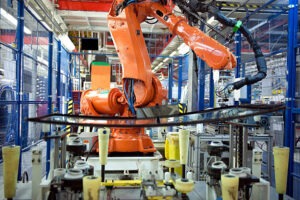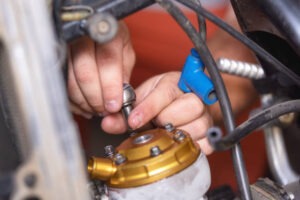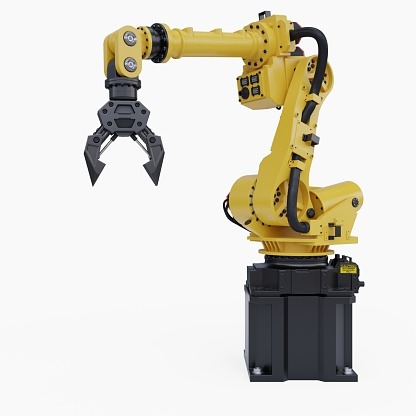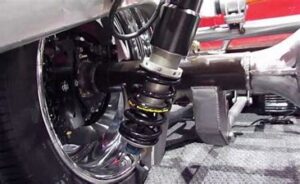A hydraulic robotic arm is a system that is a combination of a machine and hydraulic systems. It is widely applicable in all kinds of large equipment related to the field of engineering. It works similar to an arm frame of a simple crane.
This arm has several very useful properties such as being strong, and non-linear and it is coupled with rigid and flexible characteristics at the same time. The dynamic differential equation is built with the driving force of the hydraulic cylinder as the main force in the hydraulic robotic arm.

Table of Contents
Principle Of The Hydraulic Robotic Arm:
Pascal’s law is the basis of all hydraulic drive systems. All the pressure in the system is the same, the force that the fluid gives to the surroundings is, therefore, equal to the pressure times area. In such a way, a small piston feels a small force and if the piston is large, it will feel a large force. The same principle is used by a hydraulically operated pump which has a small swept volume that requires a small torque. This is in combination with a hydraulic motor that has a large swept volume which requires a large torque. In such a way, a transmission with a certain ratio could be built.

Most hydraulic drive systems make use of hydraulic cylinders. Here, the same principle is used. A small torque can be easily converted into a large force just by throttling the fluid between the generator and the motor, or with the use of some hydraulically operated pumps and/or motors that have an adjustable swept volume, the ratio of the transmission can be changed and thus adjusted very easily. In case throttling is used, the efficiency of the transmission is limited in most cases.
Hydraulic cylinders, as well as the hydraulic systems, will remain something of interest and if such a system is available, it is very easy as well as logical to use this system for the rotating drives of the cooling systems, as well. An important advantage of a hydraulic drive is its high power density as the mass of a hydraulic drive is several times smaller than the mass of an electric drive of the same power which makes its power density very high.
Working Mechanism Of The Hydraulic Robotic Arm:
A robotic arm that is hydraulically operated is usually controlled by springs filled with some fluid. It consists of various parts that are connected in a pre-designed manner. These are guided in a constrained way to obtain the required output. In the mechanism, each part of the robotic arm has been provided with a certain degree of freedom to move in a constrained way to guide other parts and also to collect items having very fewer weights and place them in other places. The complete mechanism includes a vertical link that is fixed.
To its free end is connected or better to say hinged, another horizontal link that is free to oscillate about the hinge in an up-down way of motion. A slotted type mechanism consisting of a slotted box that itself can oscillate about its hinge is connected to this link and there is a sliding link that can come out of the slot to have the movement similar to a slider in it. To this slider is connected a surface, underneath which are attached four spoons acting as arms to pick up the items. The whole mechanism is put up on a rack and pinion type mechanism which can some allow a degree of to the whole mechanism.

Activities That Can Be Done Using The Hydraulic Robotic Arm:
- The hydraulic robotic arm can reach even the greatest distance to deliver a given object.
- This arm is capable of picking up the heaviest possible object.
- The hydraulic robotic arm can deliver most of the objects in a given amount of time.
- It functions in an assembly line which is usually well defined.
- This robotic arm has a system that can very easily weigh the objects it picks up. They are also capable of battling against another arm of an object.
- These arms can rotate as well as reach and grab things easily.
- Hydraulic robotic arms are also able to dig objects and recover them as well.
Applications Of Hydraulic Robotic Arm:
These arms are used in assembly lines of mega factories to assemble various parts of a product and also to paint some vehicles.
1. What Is The Use Of A Hydraulic Arm?
2. What Are The Benefits Of The Hydraulic Robotic Arm?
Advantages of Hydraulic Robot Arms
Reduce Costs: Working with several humans can be costly because a company has to part with a lot of money in labor and related costs. However, the robotic arm can do the work of humans at a much faster rate and a more affordable cost.
3. What Is The Principle Of The Hydraulic Arm?
Conclusion:
This hydraulically operated robotic arm uses extremely simple ideas as well as really simple mechanisms to achieve a complex set of actions and is also intended to imitate the action of operators. However, these hydraulic arms can be expensive for some small-scale industries. If the greatest issue of really high initial expense is solved, a robotic hydraulic arm can be used by any kind of industry no matter it is a small scale or large scale one.
The mechanical links, as well as parts that have been fabricated, are extremely simple. This mechanism has been constrained and executed with success to perform the essential work of picking up the weight of any object and putting them into a completely different place.
I hope this article helps by providing enough information about the hydraulic robotic arm.



